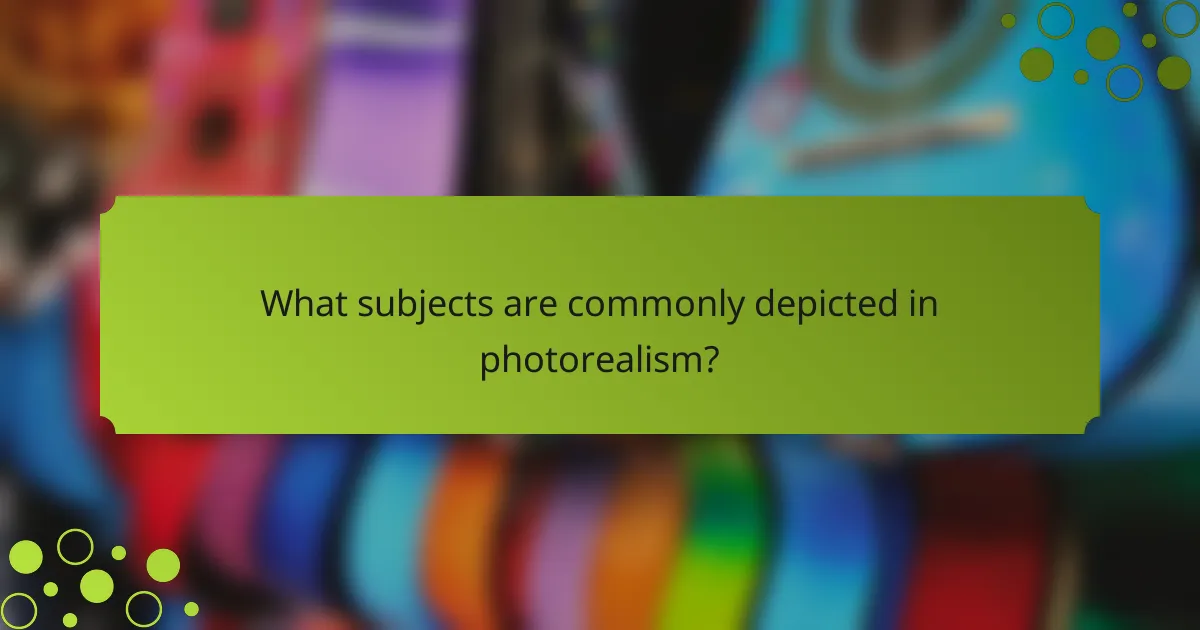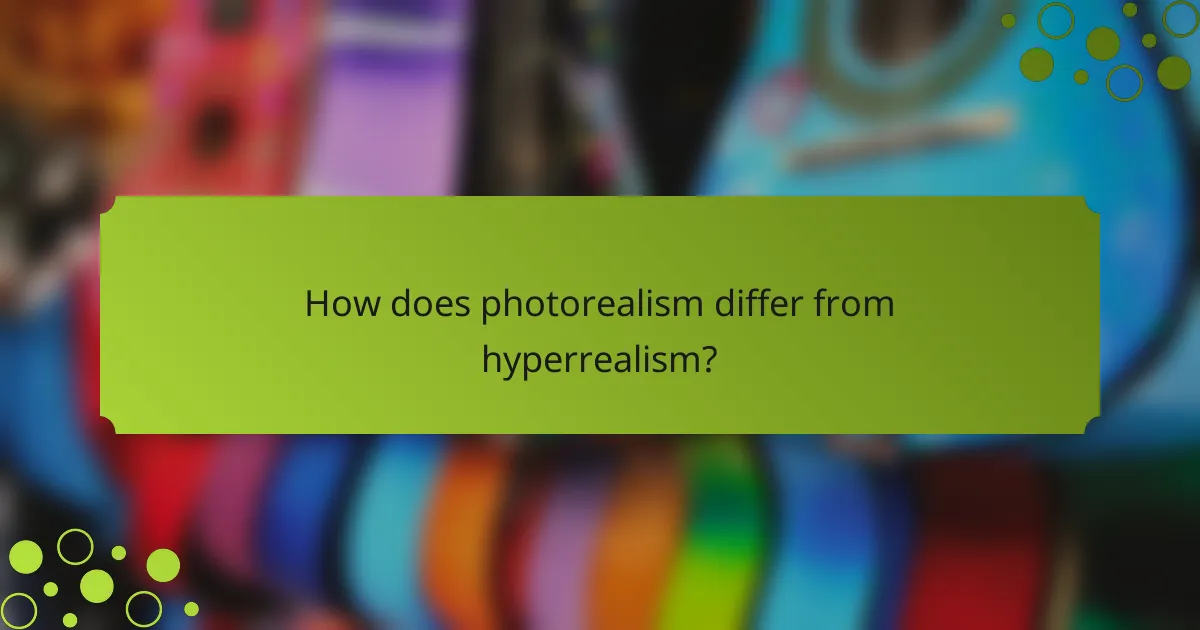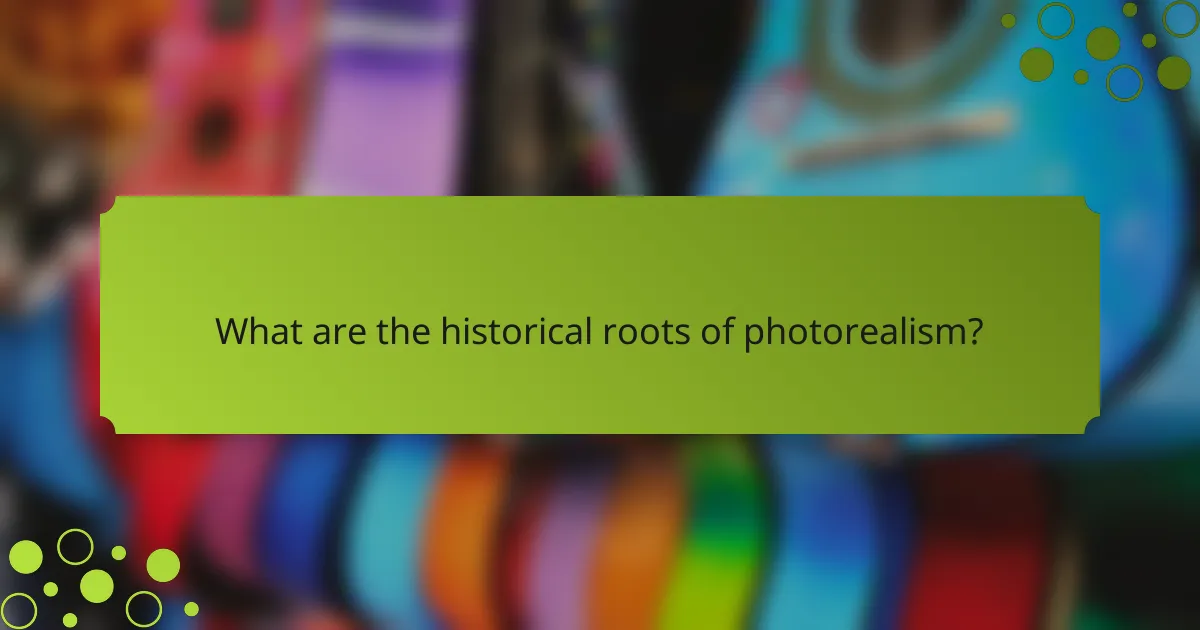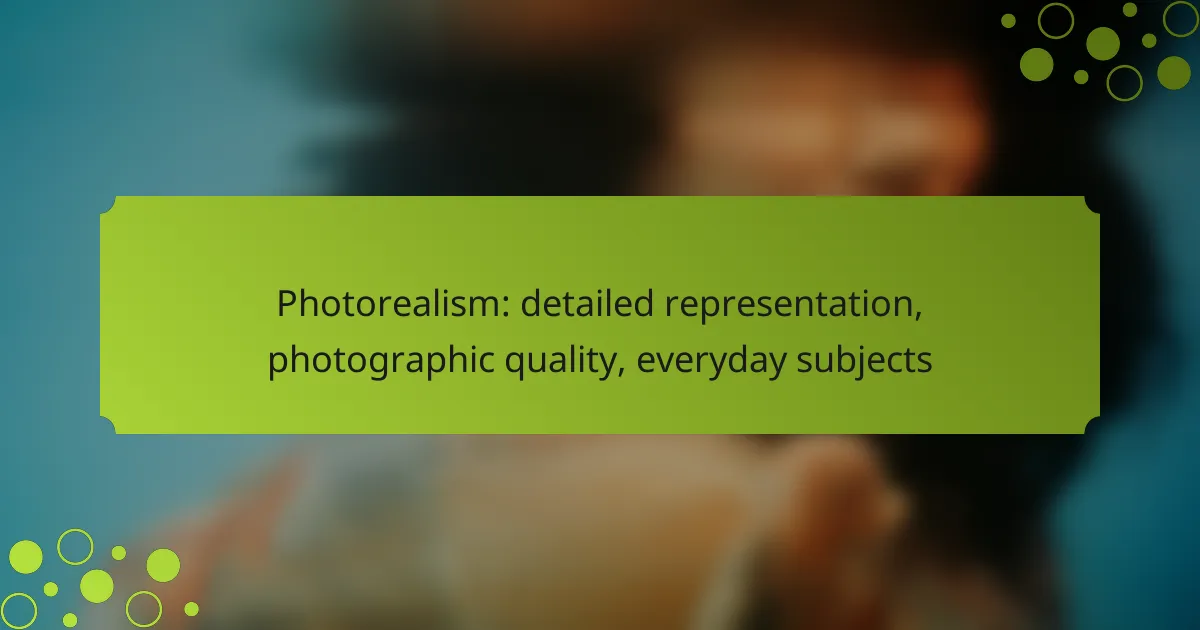Photorealism is an artistic movement that emphasizes detailed representation and photographic quality, often focusing on everyday subjects. Artists employ meticulous techniques to replicate the nuances of light, texture, and color, creating lifelike images that resonate with viewers. By transforming commonplace objects and scenes into stunning visual experiences, photorealism bridges the gap between art and reality.

How to achieve photorealism in art?
Achieving photorealism in art involves meticulous attention to detail, precise color matching, and a deep understanding of light and texture. Artists must replicate the qualities of a photograph, focusing on everyday subjects to create lifelike representations.
Techniques for realistic textures
Realistic textures can be achieved through various techniques, including layering and blending. Artists often use fine brushes or tools to build up layers of paint or digital strokes, mimicking the surface qualities of materials like skin, fabric, or metal.
Another effective method is to study the texture closely and replicate it by observing how light interacts with the surface. This can involve using stippling, cross-hatching, or digital brushes that simulate real-world textures.
Color accuracy and lighting
Color accuracy is crucial for photorealism, requiring artists to understand color theory and the effects of light. Using a limited palette can help maintain harmony, while careful observation of natural light conditions allows for realistic shadow and highlight placement.
Artists should consider the color temperature and intensity of light sources, as these factors significantly influence how colors appear. Utilizing tools like color wheels and digital color pickers can aid in achieving the desired accuracy.
Use of reference images
Reference images are essential for achieving photorealism, providing a basis for detail and accuracy. Artists should gather high-quality photographs that represent the subject matter they wish to depict, focusing on various angles and lighting conditions.
When using reference images, it’s important to analyze them critically, noting how textures, colors, and forms are represented. This analysis can guide the artist in recreating these elements in their work.
Digital tools for photorealism
Digital tools have revolutionized the approach to photorealism, offering features that enhance precision and efficiency. Software like Adobe Photoshop or Corel Painter provides a range of brushes and textures that can simulate traditional media.
Additionally, 3D modeling software can be used to create realistic lighting and textures before painting. Familiarity with these digital tools can significantly streamline the process of achieving photorealistic results.

What are the best tools for photorealistic rendering?
The best tools for photorealistic rendering include software that excels in creating highly detailed and realistic images. Key options are Autodesk 3ds Max, Blender, and Adobe Photoshop, each offering unique features and capabilities for achieving photographic quality in everyday subjects.
Autodesk 3ds Max
Autodesk 3ds Max is a powerful tool widely used in the industry for photorealistic rendering. It offers advanced features like mental ray and Arnold rendering engines, which provide high-quality output with realistic lighting and shading effects.
When using 3ds Max, pay attention to the material editor, which allows you to create complex textures and surfaces. Consider utilizing the built-in libraries for quick access to realistic materials. A common pitfall is neglecting to optimize render settings, which can lead to unnecessarily long render times.
Blender
Blender is a free and open-source software that has gained popularity for its robust rendering capabilities. The Cycles rendering engine in Blender is particularly noted for its ability to produce photorealistic images with accurate light simulation.
To achieve the best results in Blender, focus on mastering the node-based material system, which allows for intricate control over textures and lighting. Additionally, using HDRI images for environment lighting can significantly enhance realism. Be cautious of the learning curve, as Blender’s interface may be complex for new users.
Adobe Photoshop
Adobe Photoshop is essential for post-processing photorealistic images, allowing for fine-tuning and enhancements after rendering. It provides tools for color correction, retouching, and adding effects that can elevate the final output.
When using Photoshop, consider utilizing adjustment layers for non-destructive editing, which enables you to experiment without permanently altering the original image. Common mistakes include over-editing, which can detract from the realism of the image. Aim for subtle adjustments to maintain a natural look.

What subjects are commonly depicted in photorealism?
Photorealism often features subjects that are familiar and relatable, focusing on everyday objects, urban landscapes, and portraits of people. These subjects are rendered with meticulous detail, capturing the essence of reality in a way that mimics high-quality photography.
Everyday objects
Everyday objects in photorealism can include items such as kitchen utensils, furniture, or personal belongings. Artists often choose these subjects to highlight the beauty in the mundane, using techniques that emphasize texture, light, and shadow. For example, a photorealistic painting of a glass of water might showcase reflections and refractions that make it appear almost lifelike.
When creating or appreciating photorealistic art featuring everyday objects, consider the composition and how light interacts with the materials. Artists might use a limited color palette to enhance realism, focusing on the subtleties of color and form.
Urban landscapes
Urban landscapes are a popular choice in photorealism, capturing the intricate details of city life, architecture, and street scenes. These artworks often depict bustling streets, towering buildings, and the interplay of light and shadow in urban settings. A painting of a city skyline at sunset can evoke a sense of time and place, drawing viewers into the scene.
When exploring urban landscapes in photorealism, pay attention to the perspective and scale. Artists frequently use techniques like depth of field to create a sense of realism, making distant objects appear smaller and less detailed compared to those in the foreground.
Portraits of people
Portraits of people in photorealism aim to capture not just the likeness but also the personality and emotion of the subject. Artists often invest significant time in studying facial features, expressions, and even the texture of skin to achieve a lifelike representation. A well-executed portrait can convey a story or evoke a strong emotional response from the viewer.
When creating or viewing photorealistic portraits, consider the importance of lighting and shadow in defining facial features. Artists may use photographs as references but often enhance details to create a more striking and vivid portrayal of their subjects.

How does photorealism differ from hyperrealism?
Photorealism focuses on creating artwork that closely resembles high-resolution photographs, while hyperrealism takes it a step further by enhancing the details to create an almost surreal effect. Both styles aim for realism, but hyperrealism often incorporates emotional or narrative elements that go beyond mere representation.
Definition of photorealism
Photorealism is an art movement that emerged in the late 1960s and early 1970s, characterized by the meticulous reproduction of photographs in various mediums, including painting and sculpture. Artists utilize techniques such as airbrushing and layering to achieve a level of detail that makes the artwork indistinguishable from a high-quality photograph. Common subjects include landscapes, still lifes, and urban scenes.
Characteristics of hyperrealism
Hyperrealism is a genre that builds on photorealism by adding an extra layer of detail and emotional depth, often resulting in images that appear more vivid and lifelike than reality. This style frequently incorporates elements that evoke a narrative or provoke thought, such as unusual perspectives or dramatic lighting. Common techniques include the use of digital manipulation and advanced painting methods to enhance textures and colors, creating a striking visual impact.

What are the historical roots of photorealism?
Photorealism emerged as a distinct art movement in the late 20th century, characterized by its detailed representation and photographic quality. It primarily focuses on everyday subjects, capturing them with precision that often blurs the line between painting and photography.
Origins in the 1960s
Photorealism originated in the 1960s as a response to the abstract expressionism that dominated the art scene at the time. Artists sought to create works that reflected reality with meticulous detail, often using photographs as references. This movement gained momentum alongside the rise of consumer culture and mass media.
During this period, artists began experimenting with techniques that allowed them to replicate the clarity and texture of photographs. The use of airbrushes and other tools became common, enabling a smoother finish that enhanced the photorealistic effect.
Influence of photography
Photography played a crucial role in the development of photorealism, providing artists with a new way to capture and interpret their surroundings. Many photorealists used photographs as the primary source for their paintings, allowing them to focus on intricate details and lighting effects that would be challenging to achieve from life.
This reliance on photography not only influenced the techniques used but also the subjects chosen by artists. Everyday scenes, urban landscapes, and still lifes became popular themes, reflecting contemporary life and culture.
Key artists in photorealism
Several artists are pivotal in the history of photorealism, each contributing unique styles and perspectives. Chuck Close is renowned for his large-scale portraits that emphasize the grid technique, while Richard Estes is known for his urban scenes that capture reflections and light.
Other notable artists include Audrey Flack, who often incorporates personal and historical narratives into her works, and Ralph Goings, who focuses on American diners and fast food culture. Their diverse approaches showcase the breadth of photorealism as a movement.
